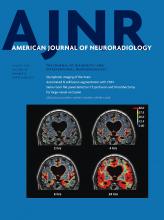Abstract
BACKGROUND AND PURPOSE: CTA is the imaging modality of choice in many institutions for the evaluation of the supraaortic vessels, but radiation exposure remains a matter of concern. Our aim was to evaluate a 70-kV protocol for CT angiography of the carotid arteries with respect to image quality and radiation exposure compared with automated tube voltage adaption.
MATERIALS AND METHODS: A total of 90 consecutive patients were included in this prospective study and randomized to the study group (n = 45, 70 kV) or control group (n = 45, automated tube voltage adaptation). Volume CT dose indices and dose-length products were recorded in the examination protocol. Image quality was assessed as arterial vessel contrast, signal-to-noise ratio, contrast-to-noise ratio, and contrast-to-noise ratio in reference to the radiation dose. Subjective overall image-quality analysis, image-artifact analysis, and diagnostic evaluation were performed by 2 observers by using a 4-point Likert scale.
RESULTS: Radiation exposure was significantly lower in the study group (volume CT dose index reduced by 22%, dose-length product reduction by 20%; each P < .001). Contrast (P = .15), SNR (P = .4), and contrast-to-noise ratio (P = .5) did not show significant differences between the groups. The contrast-to-noise ratio in reference to the radiation dose was not significantly increased using the study protocol (P = .2). Subjective image quality and visualization of pathologic findings did not differ significantly between the groups.
CONCLUSIONS: Carotid CTA using the lowest available voltage (70 kV) is feasible at very-low-dose levels, while overall image quality is comparable with protocols using automated tube voltage selection.
ABBREVIATIONS:
- A
- relative attenuation
- BMI
- body mass index
- C
- contrast
- CNR
- contrast-to-noise ratio
- CNRD
- contrast-to-noise ratio in reference to the radiation dose
- CTDIvol
- volume CT dose index
- DLP
- dose-length product
- © 2019 by American Journal of Neuroradiology







